Mini ROV Observer Market Research, 2033
The global mini rov observer market size was valued at $610.2 million in 2023, and is projected to reach $1157.7 million by 2033, growing at a CAGR of 6.8% from 2024 to 2033.
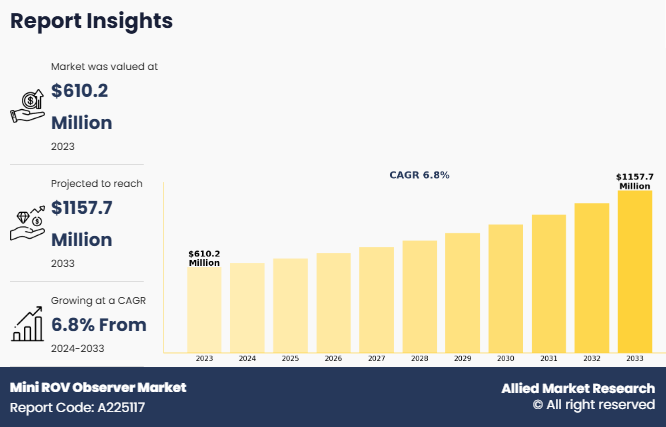
Report Key Highlighters:
- The mini ROV observer industry study covers 14 countries. The research includes regional and segment analysis of each country for the projected period 2024-2033.
- The study integrated high-quality data, professional opinions and analysis, and critical independent perspectives. The research approach is intended to provide a balanced view of global markets and to assist stakeholders in making educated decisions to achieve their most ambitious growth objectives.
- Over 3,700 product literature, annual reports, industry statements, and other comparable materials from major industry participants were reviewed to gain a better understanding of the market.
- The key players in the mini ROV observer industry are Subsea Tech, MarineNav Ltd., AC-CESS, Outland Technology, Inc., Ocean Modules, Blue Robotics Inc., Exail, Teledyne SeaBotix, Deep Trekker Inc., and VideoRay LLC. These companies have adopted strategies such as product launches, contracts, expansions, agreements, and others to improve their market positioning.
A mini ROV observer is a remotely operated vehicle (ROV) designed for underwater observation and inspection tasks. These compact and versatile vehicles are typically smaller than traditional work-class ROVs, making them portable and easier to deploy. They are equipped with advanced cameras, sensors, and lighting systems that allow operators to capture high-definition visuals and gather data from underwater environments.
Mini ROV observers are primarily used for non-intrusive observation tasks, such as inspecting underwater infrastructure, monitoring marine ecosystems, conducting scientific research, and supporting aquaculture operations.
Innovations in robotics, artificial intelligence (AI), and remotely operated vehicles (ROVs) have significantly improved the feasibility and cost-effectiveness of underwater exploration. In addition, rise in number of collaborative international underwater projects and global investment in marine research have positioned the region as a leader in global efforts to study and manage marine resources sustainably.
For instance, in December 2024, the U.S. Navy introduced its new unmanned submarine, the Orca XLUUV, as part of its efforts to modernize naval operations. This advanced underwater vehicle is designed as a multi-mission platform, offering extended range and enhanced strategic capabilities to the Navy fleet. The U.S. Navy aims to improve operational effectiveness and reduce risks to personnel by leveraging unmanned maritime systems such as the Orca. This initiative reflects a broader strategy to upgrade naval warfare capabilities and address emerging challenges in underwater surveillance & defense.The global mini ROV observer market forecast indicates steady growth, driven by rising demand for underwater inspections and marine research applications.
The global mini ROV observer market growth is driven by rise in demand for underwater inspections across industries such as oil & gas, marine research, and defense, as well as the increased adoption of Mini ROVs for environmental monitoring and disaster response due to their portability and cost-effectiveness. In addition, advancements in miniaturization technology have enhanced the capabilities of Mini ROVs for detailed inspections in hard-to-reach underwater areas. However, factors such as limited battery life and operational time, high initial costs, and maintenance requirements of advanced Mini ROV systems restrain market growth. On the contrary, the growth in underwater tourism and recreation, along with rise in demand for renewable energy, is expected to provide lucrative growth opportunities for the market.
The mini observation ROV market is segmented on the basis of product type, end user, application, and region. By product type, the market is categorized into micro observation ROVs and mini observation ROVs. By end user, it is divided into oil & gas industry, military & defense, environmental & research organizations, and others. Depending on the application, the market is classified into inspection & maintenance, research & monitoring, and search, rescue, & others. Region-wise, the market is analyzed across North America, Europe, Asia-Pacific, and LAMEA.
Leading players and their key business strategies have been analyzed in the report to gain a competitive insight into the market. Key players covered in the report include Subsea Tech, MarineNav Ltd., AC-CESS, Outland Technology, Inc., Ocean Modules, Blue Robotics Inc., Exail, Teledyne SeaBotix, Deep Trekker Inc., and VideoRay LLC.
Key Developments
The leading companies have adopted strategies such as acquisition, agreement, expansion, partnership, contracts, and product launches to strengthen their market position.
- In September 2024, Voyis integrated its Discovery Stereo camera with Seatronics VALOR ROV, creating a versatile solution for subsea applications such as infrastructure inspection and environmental monitoring. This integration enhances the ROV precision and functionality, enabling detailed 3D imaging and accurate data collection in underwater environments. The partnership aims to boost operational efficiency and expand subsea inspection capabilities to meet the needs of various industries. These compact and portable Mini ROVs provide an efficient and cost-effective means for conducting underwater inspections and collecting critical data in challenging environments.
- February 2024, Subsea Tech's expanded its Mini TORTUGA XP4, integrated with the IVM Hydro 300 sensor. Through this expansion, it gains traction with clients impressed by its precise sub millimetric 3D modeling capabilities. With increasing interventions in pipe, dock door, and trash rack inspections, the adoption of advanced photogrammetry marks a transformative step in data quality, fueling further growth opportunities.
- In May 2024, VideoRay LLC contracted with IDIQ at $92.6 million to produce,sustain, and develop the MK20 Defender ROV platform for the US Navy Maritime Expeditionary Standoff Response (MESR) program. This contract highlights VideoRaysrole in advancing underwater defense technology to support critical maritime operations.
Segmental analysis
The mini observation ROV market is segmented on the basis of product type, end user, application, and region. By product type, the market is categorized into micro observation ROVs and mini observation ROVs. By end user, it is divided into oil & gas industry, military & defense, environmental & research organizations, and others. Depending on the application, the market is classified into inspection & maintenance, research & monitoring, and search, rescue, & others. Region-wise, the market is analyzed across North America, Europe, Asia-Pacific, and LAMEA.
By Product Type
By product type, the market is categorized into micro observation ROVs and mini observation ROVs. The mini observation ROVs segment accounted for the largest mini ROV observer market share in 2023. Technological innovations are pushing the boundaries of depth capabilities, sensor integration, and operational complexity. Industries like oil and gas, marine research, and defense are investing heavily in advanced mini ROV technologies. The ability to conduct complex underwater missions with greater precision and longer operational times is driving significant market expansion. Improved battery technologies, advanced imaging systems, and enhanced maneuverability are key factors propelling the mini ROV market forward.
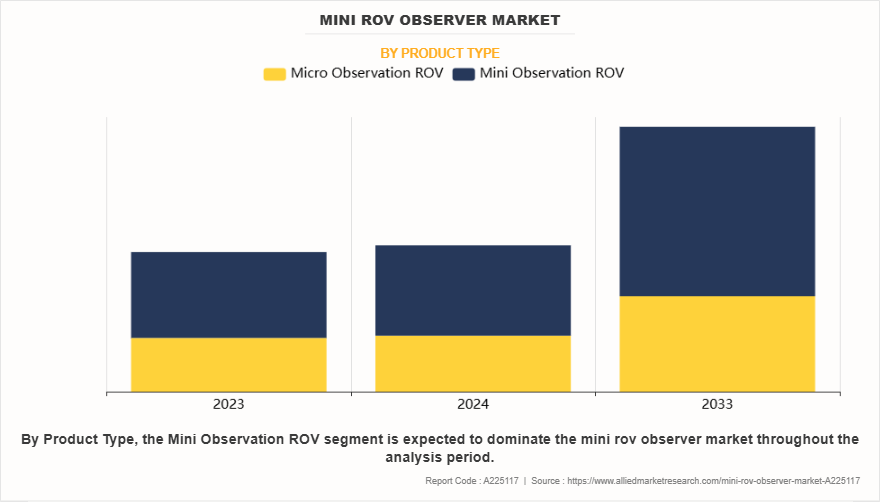
By End User
By end user, it is divided into oil & gas industry, military & defense, environmental & research organizations, and others. The oil & gas industry segment accounted for the largest market share in 2023. The oil and gas industry remains a dominant end-user of observation ROVs, driven by the need for regular maintenance and inspection of offshore pipelines, rigs, and subsea infrastructure. A key trend in this segment is the increasing reliance on ROVs for inspecting aging underwater infrastructure to ensure operational safety and compliance with environmental standards.
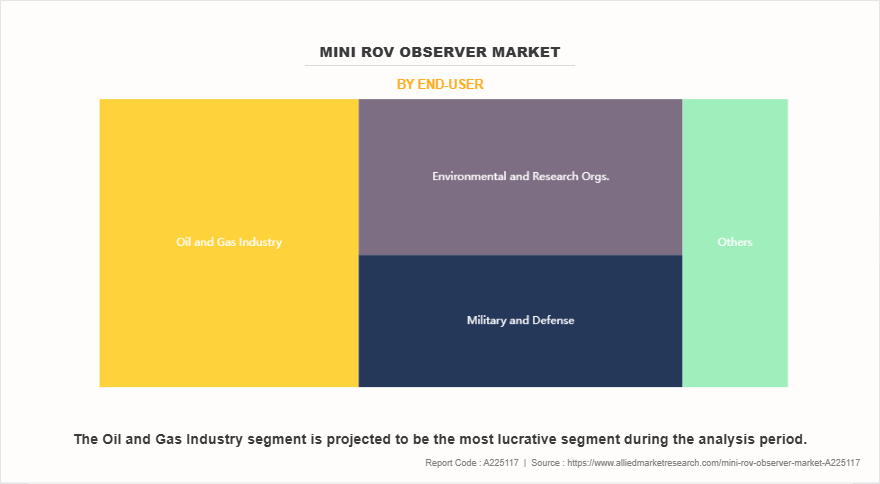
By Application
By application, the market is classified into inspection & maintenance, research & monitoring, and search, rescue, & others. The inspection & maintenance segment accounted for a dominant market share in 2023, driven by the need for regular monitoring of underwater infrastructure. Key trends include the increasing use of ROVs for inspecting pipelines, offshore platforms, and subsea cables in industries such as oil and gas and renewable energy.
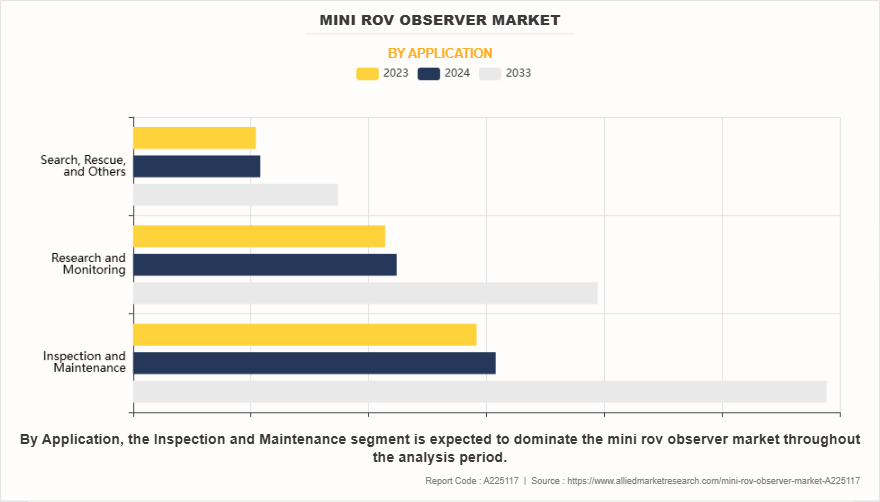
By Region
Region wise, North America held the largest market share in 2023. In North America countries such as U.S., and Canada are increasingly investing in their navy to safeguard their coastal area and increase global reach. Innovations in robotics, AI, and remotely operated vehicles (ROVs) have made underwater exploration more feasible and cost-effective.
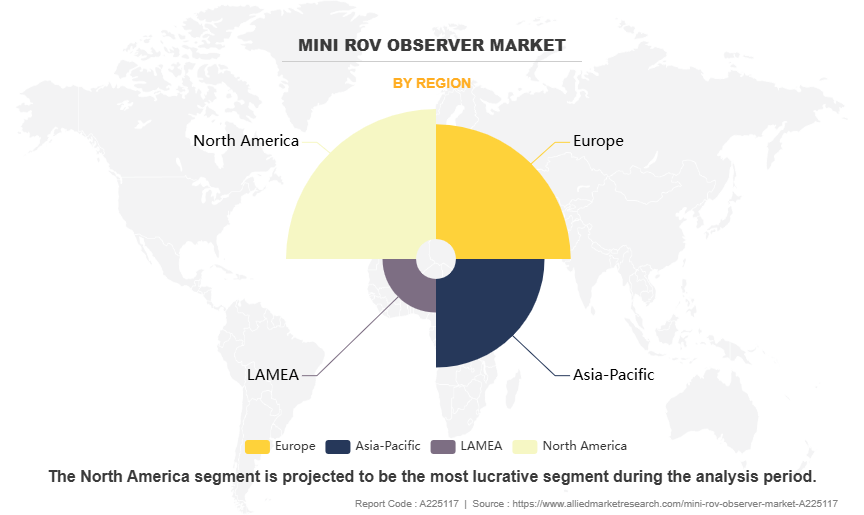
Rise in demand for underwater inspections in various industries, such as oil and gas, marine research, and defense
Increase in demand for underwater inspections across various industries, including oil & gas and marine research, & defense drives significant growth in the Mini ROV Observer market. For instance, in July 2024, the Spanish Army chose the Tortuga XP4 ROV for its Search & Rescue missions in inland waters, recognizing its exceptional underwater inspection and manipulation capabilities, even in challenging conditions such as low visibility and strong currents. Following its adoption by the French, Portuguese, and Indonesian Navies, this marks the Tortuga XP fourth success with armed forces within a year, showcasing its growing reputation in military operations. Moreover, these industries require reliable and cost-effective solutions to conduct inspections in challenging and often hazardous underwater environments. Mini ROVs (Remotely Operated Vehicles) are ideal for such tasks due to their compact size, maneuverability, and ability to reach hard-to-access areas that larger ROVs cannot. In oil and gas, Mini ROVs are used to inspect pipelines, platforms, and subsea infrastructure, minimizing the need for costly and time consuming manual inspections. In marine research, these vehicles are used for coral reef monitoring, marine life studies, and environmental assessments. In the defense sector, mini ROVs are essential for underwater reconnaissance and bomb disposal. As these industries continue to prioritize efficiency and safety in underwater operations, the demand for mini ROV Observer systems is expected to rise.
Increased adoption of Mini ROVs for environmental monitoring and disaster response due to their portability and cost-effectiveness
Surge in adoption of Mini ROVs for environmental monitoring and disaster response is significantly driving mini ROV observer market demand. For instance, in September 2024, Voyis integrated its Discovery Stereo camera with Seatronics VALOR ROV, creating a powerful solution for subsea applications such as infrastructure inspection and environmental monitoring. This combination enhances the ROV precision and versatility, enabling detailed 3D imaging and accurate data collection in underwater environments. The partnership aims to improve operational efficiency and expand the capabilities of subsea inspections, addressing diverse industry needs. These compact and portable remotely operated vehicles offer an efficient and cost-effective solution for conducting underwater inspections and data collection in challenging environments.
Mini ROVs are extensively used for assessing underwater ecosystems, monitoring coral reefs, and conducting pollution studies. Their ability to reach confined spaces and operate in hazardous conditions makes them an ideal choice for disaster response scenarios, such as inspecting underwater structures after natural disasters or locating submerged debris. In addition, advancements in imaging and sensor technologies have enhanced the capabilities of Mini ROVs, allowing for precise data acquisition and real-time analysis. As governments and organizations place greater emphasis on environmental sustainability and disaster preparedness, the demand for Mini ROVs continues to grow, cementing their importance in addressing critical environmental and safety challenges.
Limited battery life and operational time, affecting the efficiency of extended underwater tasks
Limited battery life and operational time pose significant challenges to the efficiency and functionality of mini remotely operated vehicles (ROVs), thereby hampering the demand in the mini ROV observer market. These compact underwater systems, while versatile and cost-effective, often face constraints when deployed for extended tasks such as deep-sea exploration, pipeline inspections, or prolonged environmental monitoring. The short operational duration forces frequent retrieval and recharging, interrupting workflows and increasing overall project time. For industries such as oil and gas, marine research, and defense, where continuous and reliable operation is critical, these limitations can diminish the appeal of Mini ROVs. While advancements in battery technology are being explored, current energy storage solutions have yet to fully meet the operational demands of these underwater vehicles. The need for consistent, long-lasting power sources remains a critical barrier, pushing manufacturers to prioritize innovative energy solutions to overcome this limitation and enhance market growth potential.
Underwater tourism and recreation
The growing interest in exploring underwater environments has created significant opportunities in the mini ROV observer market. With the increasing popularity of activities such as scuba diving, underwater photography, and marine exploration, there is a demand for cost-effective and user-friendly tools to enhance the underwater experience. Mini ROVs are well-suited for this purpose, as they allow recreational users and tourists to observe and capture images of marine life, coral reefs, and shipwrecks without needing advanced diving skills. Moreover, the development of underwater resorts and guided marine tours is further driving the adoption of Mini ROVs. These ROVs provide a unique way for tourists to explore underwater environments safely and comfortably, offering high-definition cameras and real-time video feeds. As a result, mini ROVs are increasingly integrated into tourism and recreation services, especially in regions with rich marine biodiversity, such as Southeast Asia and the Caribbean. The expansion of underwater tourism represents a promising opportunity for the Mini ROV market, as it combines technological innovation with the growing demand for unique travel experiences.
Key Benefits For Stakeholders
- This report provides a quantitative analysis of the market segments, current trends, estimations, and dynamics of the mini rov observer market analysis from 2023 to 2033 to identify the prevailing mini rov observer market opportunities.
- The market research is offered along with information related to key drivers, restraints, and opportunities.
- Porter's five forces analysis highlights the potency of buyers and suppliers to enable stakeholders make profit-oriented business decisions and strengthen their supplier-buyer network.
- In-depth analysis of the mini rov observer market segmentation assists to determine the prevailing market opportunities.
- Major countries in each region are mapped according to their revenue contribution to the global market.
- Market player positioning facilitates benchmarking and provides a clear understanding of the present position of the market players.
- The report includes the analysis of the regional as well as global mini rov observer market trends, key players, market segments, application areas, and market growth strategies.
Mini ROV Observer Market Report Highlights
| Aspects | Details |
| Market Size By 2033 | USD 1157.7 million |
| Growth Rate | CAGR of 6.8% |
| Forecast period | 2023 - 2033 |
| Report Pages | 280 |
| By Product Type |
|
| By End-User |
|
| By Application |
|
| By Region |
|
| Key Market Players | VideoRay LLC, Outland Technology, Inc., AC-CESS, Teledyne SeaBotix, Ocean Modules, Deep Trekker inc., Subsea Tech , Exail, MarineNav Ltd., Blue Robotics Inc. |
The largest regional market for Mini ROV Observer is North America.
The key players in the mini ROV observer market are Subsea Tech, MarineNav Ltd., AC-CESS, Outland Technology, Inc., Ocean Modules, Blue Robotics Inc., Exail, Teledyne SeaBotix, Deep Trekker Inc., and VideoRay LLC. These companies have adopted strategies such as product launches, contracts, expansions, agreements, and others to improve their market positioning.
The leading application of Mini ROV Observer Market is inspection and maintenance.
The global mini ROV observer market was valued at $610.2 million in 2023, and is projected to reach $1157.7 million by 2033, growing at a CAGR of 6.8% from 2024 to 2033.
The upcoming trends of Mini ROV Observer Market in the globe are , the growth in underwater tourism and recreation, along with rise in demand for renewable energy.
Loading Table Of Content...
Loading Research Methodology...



